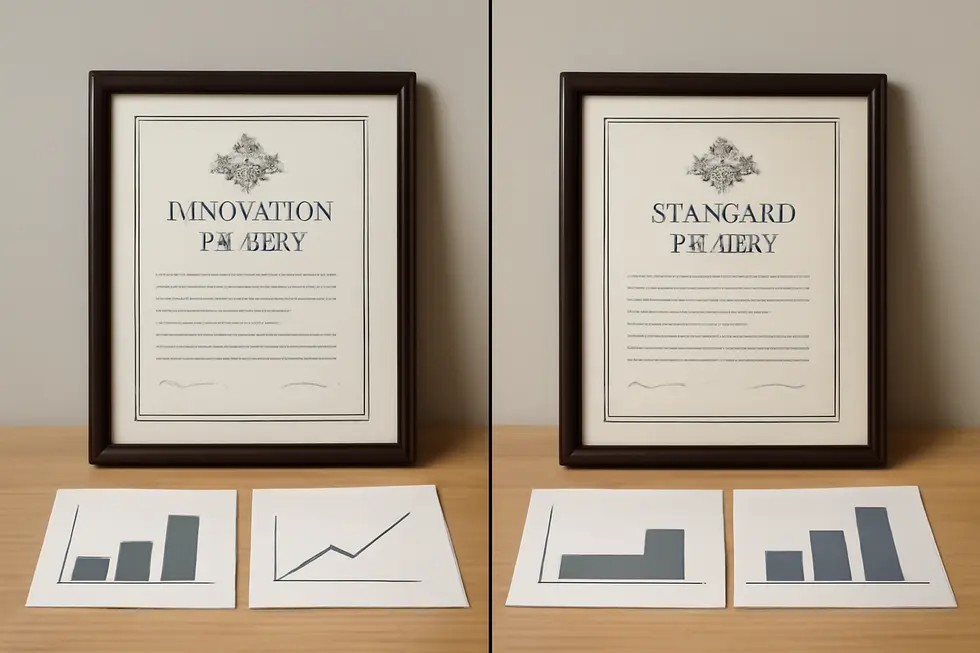Introduction
Innovation patents provide a unique intellectual property tool designed to protect incremental technological advancements that may not meet the higher inventive standards of conventional patents. For business owners navigating competitive markets, understanding how innovation patents fit into your broader IP strategy is essential to securing your inventions quickly and efficiently. This article explores the legal framework underpinning innovation patents, examines their strategic business implications, and compares them directly with standard patents. It also sheds light on jurisdictional variations and the technological nuances that influence their practical use. By examining these interconnected aspects, business owners gain a comprehensive understanding of how innovation patents can accelerate and strengthen your competitive edge in fast-moving industries.
Tables of Contents
Chapter 1: Understanding the Legal Framework of Innovation Patents
- Core Patentability Criteria Shaping Innovation Patent Protection
- Navigating Strategic Choices and Procedural Pathways in Innovation Patent Protection
Chapter 2: Strategic Business Implications of Innovation Patents
- Harnessing Innovation Patents for Technological Edge and Market Leadership
- Harnessing Economic Value and Commercial Potential through Innovation Patents
Chapter 3: Comparative Analysis of Innovation Patents and Standard Patents
- Navigating Technological and Legal Thresholds: Distinctions Between Innovation and Standard Patents
- Balancing Speed and Strength: Economic and Strategic Dimensions of Innovation versus Standard Patents
Chapter 4: Technological and Jurisdictional Nuances of Innovation Patents
- Navigating the Core Patentability Criteria: Novelty, Usefulness, and Inventive Step in Innovation Patents
- Navigating Jurisdictional Complexities: Legal Frameworks and Enforcement of Innovation Patents Across Borders
Chapter 1: Understanding the Legal Framework of Innovation Patents

1. Core Patentability Criteria Shaping Innovation Patent Protection
At the heart of the legal framework governing innovation patents lie fundamental patentability principles that ensure inventions qualify for protection while advancing technological progress. Innovation patents focus on safeguarding incremental improvements that may not meet the more stringent inventive step thresholds of standard patents, yet still contribute valuable advances to their fields.
Central to this legal structure is the requirement of novelty. An innovation patent is only granted to inventions that are genuinely new, meaning they have not been previously disclosed, used publicly, or patented before the filing date. Patent examiners conduct comprehensive reviews of existing prior art—public knowledge and technologies—to confirm an invention’s originality. This condition helps maintain a clear boundary between proprietary inventions and the public domain.
Closely linked to novelty is the concept of non-obviousness, albeit evaluated with a lower threshold for innovation patents. Unlike full utility patents, which require a significant inventive step beyond existing knowledge, innovation patents accept inventions that demonstrate an incremental advancement understandable to a person skilled in the field. This relaxed standard accommodates smaller, stepwise technological developments without undermining the incentive to innovate.
Equally essential is the utility criterion, which mandates that an invention must have a specific and credible practical use. The invention must be functional, offering tangible benefits rather than mere theoretical ideas or speculative concepts. This ensures innovation patents protect inventions with real-world applicability, fostering commercial and industrial exploitation.
An underappreciated yet foundational pillar is the obligation for full disclosure or enablement. Patent applications must describe the invention in sufficient detail, enabling someone skilled in the relevant art to reproduce it without undue experimentation. This transparency fosters knowledge dissemination, enabling others to build upon the patented technology once protection expires. The application is also expected to disclose the best mode known for practicing the invention, ensuring inventors cannot conceal optimal implementations. This balance between exclusivity and public benefit lies at the core of patent law philosophy.
In specific technical domains, such as chemistry or biotechnology, innovation patents often require more precise structural descriptions and supporting experimental data to meet these patentability standards. This reflects the complexity and specialized nature of innovations in such fields.
Together, these criteria—novelty, a moderated inventive step, utility, and robust disclosure—form a coherent legal foundation. They safeguard inventors’ rights by granting exclusive control over their creations while encouraging the flow of technological knowledge. This framework enables businesses and innovators to secure legal certainty for incremental improvements that drive competition and commercialization agility.
For further understanding of related intellectual property protections and how various rights interconnect, exploring comprehensive resources on trademark protection may provide valuable insights.
2. Navigating Strategic Choices and Procedural Pathways in Innovation Patent Protection
Innovation patents represent a unique intersection of legal requirements and strategic business considerations. Their legal framework is shaped not only by procedural rules but also by how innovators deploy these rights to safeguard and capitalize on technological advances that may be incremental yet commercially significant. Understanding this duality offers critical insights into the patent system’s role in supporting innovation.
From a strategic perspective, businesses often leverage innovation patents as part of a layered intellectual property portfolio. These patents offer agility: firms can rapidly secure protection for inventions that might not meet the high inventive step thresholds demanded by standard utility patents. This speed is crucial in industries where product life cycles are short and competition intense. By filing innovation patents concurrently or ahead of utility patents—a tactic sometimes referred to as “double filing”—companies can establish early rights, creating a competitive buffer while preparing more robust patent applications. Furthermore, innovation patents can signal technological leadership to investors and partners, enhancing market positioning even if the protection duration is limited.
Integration of frameworks such as the Resource-Based View underscores how innovation patents become strategic assets, supporting firms’ capabilities to sustain long-term competitive advantage. Dynamic Capabilities Theory, similarly, emphasizes how ongoing adaptation involves intelligently combining these patents into broader innovation management and commercialization strategies.
Procedurally, innovation patents benefit from simplified application processes and reduced examination rigor. Unlike standard patents, which undergo comprehensive substantive examination, innovation patents often rely on preliminary examinations that confirm basic eligibility criteria: novelty, usefulness, and a lowered inventive step. This expedites the grant timeline and reduces costs, but may also result in less comprehensive scrutiny. Detailed patent drawings and clear descriptions remain essential, as they underpin the clarity necessary for enforceability and public understanding.
The procedural streamlining balances encouraging the protection of smaller, stepwise inventions while mitigating the administrative burden on patent offices. However, this also means enforcement might pose challenges compared to utility patents, requiring firms to carefully weigh the trade-offs between speed, scope, and strength of protection.
Together, these strategic and procedural dimensions forge the legal ecosystem in which innovation patents operate. They illuminate how patent policy fosters technological progress by accommodating incremental innovation and fast-paced development. Recognizing the synergy between firm-level IP strategies and procedural frameworks is vital to harnessing innovation patents effectively within the broader scope of intellectual property rights.
For deeper understanding of the formal procedural requirements, such as patent drawings and their role in application quality, see the comprehensive guide on patent procedural rules available at Patent drawings and procedural rules.
Chapter 2: Strategic Business Implications of Innovation Patents

1. Harnessing Innovation Patents for Technological Edge and Market Leadership
Innovation patents play an essential role in advancing a company’s technological edge while simultaneously shaping its competitive stance within dynamic markets. At their core, these patents encourage continuous technological refinement by securing exclusive rights that motivate investment in inventive improvements. This sense of ownership pushes firms to explore novel approaches and incremental breakthroughs, particularly in sectors where rapid development cycles demand swift protection of small but meaningful innovations. For instance, industries like automotive engineering and biotechnology benefit from innovation patents, which enable companies to safeguard advancements such as next-generation battery technologies or new medical compounds quickly and cost-effectively.
From a competitive standpoint, innovation patents act as strategic levers that help companies establish or defend market positions without the extensive time and cost investments required for full utility patents. Their focused protection of smaller technological steps is especially valuable for startups and firms navigating fast-evolving product landscapes, as it permits timely exclusivity and serves as a transparent signal of inventive activity to investors and partners. Well-crafted innovation patent portfolios enhance company valuations by demonstrating a tangible commitment to research and development, thus attracting capital and facilitating licensing opportunities. Furthermore, these patents serve as bargaining chips in cross-licensing agreements and joint ventures, supporting collaboration and defensive tactics against infringement threats.
For businesses, the strategic use of innovation patents entails more than just securing legal rights; it requires an integrated approach that aligns intellectual property actions with broader corporate goals. This includes carefully timing patent filings to stay ahead of competitors and balancing the scope of protection to optimize resource allocation. Firms must also consider the shorter lifespan of innovation patents when planning product life cycles and market entry strategies, making decisions that weigh immediate competitive gains against long-term technological leadership.
By leveraging innovation patents as dynamic assets, businesses can better navigate the interplay between fast-paced technological advancements and evolving market demands. Understanding how these patents influence both invention incentives and competitive positioning is pivotal for shaping resilient strategies that foster growth and profitability in innovation-driven industries. For further insights on protecting intellectual property dimensions related to trademarks and business identity, companies may explore resources on trademark protection for business names and logos.
2. Harnessing Economic Value and Commercial Potential through Innovation Patents
Innovation patents serve as pivotal assets in the economic and commercial strategies of businesses navigating fast-evolving technological landscapes. By granting exclusive rights to novel yet incremental inventions, innovation patents reduce market uncertainties and create tangible value, which is indispensable for attracting investment and driving growth. The economic advantage stems largely from this exclusivity, as protected innovations enable companies to secure market share, often commanding premium pricing due to the temporary monopoly they enjoy. This exclusivity not only mitigates competitive pressures but also signals quality and commercial viability to investors—an especially critical factor for startups and emerging firms in capital-intensive sectors like biotechnology and software.
The strategic significance extends beyond direct protection; innovation patents act as a currency in the commercialization ecosystem. Companies frequently leverage these patents to unlock diverse revenue streams such as licensing agreements, technology transfer, or the creation of spin-offs based on patented inventions. Licensing arrangements, particularly with larger industry players equipped with broad manufacturing and distribution capabilities, fast-track market penetration and amplify adoption rates. Furthermore, when innovation patents tie into industry standards—as seen with many AI-related technologies—they generate sustained royalty flows, reinforcing long-term profitability.
From a business perspective, viewing innovation patents solely as legal formalities overlooks their full strategic potential. When integrated thoughtfully into broader business objectives, they enhance company valuation, empower negotiations, and underpin competitive positioning. Effective patent strategies are attuned to specific business milestones and prioritize protecting core technological differentiators without expending excessive resources. Precise timing and carefully scoped filings can substantially influence a company’s ability to capitalize on its innovation over time.
Additionally, innovation patent portfolios provide rich strategic intelligence. Analyzing filing trends and citation networks reveals competitors’ research directions and highlights whitespace opportunities—unexplored technological areas ripe for investment. This intelligence informs not only defensive patenting but also guides R&D prioritization and partnership formation, embedding intellectual property deeply into overarching innovation management practices.
Overall, innovation patents act as economic enablers and commercialization accelerators. They reduce risk, open multifaceted commercial pathways, and serve as critical instruments in aligning intellectual property assets with business strategy. For companies aiming to seize competitive advantages amid rapid technological shifts, an integrated approach leveraging the economic and commercialization dimensions of innovation patents is essential.
You may also find valuable insights into effective intellectual property practices in business in the article on company intellectual property protection.
Chapter 3: Comparative Analysis of Innovation Patents and Standard Patents

1. Navigating Technological and Legal Thresholds: Distinctions Between Innovation and Standard Patents
Navigating Technological and Legal Thresholds: Distinctions Between Innovation and Standard Patents
Innovation patents and standard patents serve distinct roles within patent law, primarily differentiated by their technological and legal thresholds. These differences shape the nature of protection, examination rigor, and strategic utility each type of patent offers to inventors and businesses.
At the core of technological assessment lies the concept of inventive step. Standard patents demand a high inventive threshold, requiring inventors to demonstrate non-obviousness—meaning the invention must be a significant breakthrough over existing knowledge, not merely an obvious alternative. Patent offices such as the United States Patent and Trademark Office or the European Patent Office apply rigorous scrutiny, often evaluating whether the invention unexpectedly solves a technical problem. In contrast, innovation patents embrace a lower benchmark known as an “innovative step.” This lighter threshold recognizes inventions that introduce incremental improvements rather than groundbreaking advances. For example, in jurisdictions like Australia, innovation patents protect minor modifications that enhance functionality but may not meet the stricter inventive criteria needed for standard patents.
Legally, these differences are further emphasized through their examination and protection terms. Standard patents undergo a detailed substantive examination, ensuring compliance with novelty, inventive step, and enablement requirements. This thorough vetting supports a longer monopoly period, typically 20 years from filing, reflecting the investment needed to develop significant inventions. Alternatively, innovation patents often feature an expedited or simplified examination process, sometimes limited to formalities or only a cursory review of novelty and the lower inventive threshold. Their protection term is accordingly shorter, usually around 8 years, matching the intent to encourage faster commercialization of smaller-scale innovations.
The scope and enforceability of protection differ as well. Standard patents generally provide broader claim coverage encompassing fundamental technological advances, enabling stronger enforcement rights and greater commercial leverage. Innovation patents, by design, deal with narrower claims centered on incremental changes. Though easier and quicker to obtain, innovation patents may face challenges in enforcement and litigation due to their reduced inventive step requirement.
These distinctions make both patent types complementary in strategy. While standard patents safeguard transformative inventions with robust legal cover, innovation patents enable creators—especially startups or fast-moving firms—to swiftly protect incremental improvements, maintaining a competitive edge with less cost and delay.
Understanding these technological and legal thresholds is essential for informed intellectual property management, allowing businesses to match patent type with their innovation’s nature and market demands. For more insight into developing a strong intellectual property portfolio, exploring guidelines related to intellectual property protection can offer valuable perspectives.
2. Balancing Speed and Strength: Economic and Strategic Dimensions of Innovation versus Standard Patents
Balancing Speed and Strength: Economic and Strategic Dimensions of Innovation versus Standard Patents
Innovation patents and standard patents occupy distinct yet complementary niches within intellectual property systems, each shaping economic incentives and business strategies in unique ways. Innovation patents offer accelerated protection for incremental technological improvements, typically lasting up to eight years. Their streamlined examination procedures and lower inventive step requirements enable inventors—especially startups and small enterprises—to secure rapid, cost-effective legal rights. This agility supports faster market entry and competitive positioning, catering to industries where swift iterative development is crucial. Economically, innovation patents foster a dynamic environment that encourages the dissemination and refinement of minor advances, stimulating competition without demanding the high barriers associated with groundbreaking inventions.
Conversely, standard patents provide robust protection for fundamental inventions, generally spanning twenty years. Their rigorous examination upholds stringent standards of novelty and non-obviousness, producing high-quality patents that underpin substantial economic returns. This exclusivity incentivizes large-scale investments in complex research and development, prevalent in sectors like pharmaceuticals, biotechnology, and advanced electronics. The resulting monopoly rights facilitate market leadership, enable cost recovery for costly innovation processes, and support strategic deterrence against competitors. Economically, these patents drive transformative technological progress and contribute significantly to long-term growth but may also introduce barriers to rapid diffusion and raise litigation risks if not carefully managed.
Strategically, innovation patents function as flexible tools for building patent portfolios quickly, protecting niche improvements, and enhancing licensing leverage. Companies often use them defensively or as stepping stones to standard patents, thereby maximizing intellectual property coverage while managing costs. Their shorter term and narrower scope make them less potent in exclusionary power but highly valuable in fast-paced markets where timing is critical.
Standard patents demand meticulous claim preparation to satisfy demanding legal criteria, especially in emerging technologies such as artificial intelligence. Their strategic role encompasses securing market exclusivity, forging partnerships, driving investor confidence, and deterring infringement through strong legal remedies.
Taken together, innovation patents complement standard patents by bridging the gap between unprotected minor enhancements and full patent protection. This dual system aligns intellectual property protection with diverse innovation cycles and business scales. For more insights into how intellectual property fosters innovation and economic development, exploring resources on intellectual property protection for business owners is beneficial, such as company intellectual property protection.
Chapter 4: Technological and Jurisdictional Nuances of Innovation Patents

1. Navigating the Core Patentability Criteria: Novelty, Usefulness, and Inventive Step in Innovation Patents
Innovation patents are distinct from standard utility patents primarily because they set a lower threshold on the inventive step while still demanding that inventions satisfy key patentability criteria: novelty, usefulness, and non-obviousness. The interaction between these requirements defines the technological essence of innovation patents and shapes their strategic application in protecting incremental advancements.
The first critical factor, novelty, requires the invention to be truly new. This means it must not have been disclosed publicly through any prior art before the patent filing date. Prior art encompasses existing patents, literature, products, and any form of public knowledge. For example, in sectors like artificial intelligence, even if certain algorithms are well-known, applying them in a unique manner or combining them with new technical elements can fulfill the novelty requirement. The challenge lies in exhaustive prior art searches to confirm no identical or highly similar disclosures exist that would negate novelty.
Usefulness or utility is another foundational requirement. It demands that the invention offer practical value, working reliably as described and delivering a tangible benefit. Patent applications lacking a clear, functional advantage or describing abstract ideas without technical implementation typically fail this criterion. Demonstrating usefulness helps ensure that patents protect genuine technological contributions rather than conceptual or speculative ideas.
The inventive step, often called non-obviousness, is where innovation patents differ most from standard patents. While standard patents require a high level of inventive ingenuity, innovation patents adopt a more lenient approach. The invention must still involve something beyond what a skilled person in the relevant field would find obvious, but the standard tolerates smaller, incremental improvements. This lower bar supports protection for rapid, stepwise innovation commonly seen in fields like communication technologies and software development. However, drafting claims that strike a balance between breadth and specificity remains essential. Broad claims maximize protection but risk invalidation if prior art or obviousness can be established, while narrow claims may limit commercial value.
Additional technical nuances include the necessity of detailed enablement, where the patent must describe the invention with sufficient clarity to allow replication without undue experimentation. This technical disclosure reassures patent offices and competitors of the invention’s feasibility and scope. In cases of software or digital technologies, highlighting a concrete technical effect—such as enhanced processing efficiency or security improvements—strengthens the patent’s validity.
Global patent strategies further complicate these technological nuances. Since patent laws and thresholds vary by jurisdiction, inventors must tailor applications to meet diverse legal standards and consider treaties like the Patent Cooperation Treaty for broader protection.
Overall, mastering the balance among novelty, utility, and inventive step is critical in leveraging innovation patents effectively. The intricacies of these criteria require thorough technical analysis and strategic drafting to secure robust and enforceable protection in a competitive and evolving innovation landscape. For a deeper understanding of these patentability fundamentals, readers can consult detailed resources on patent novelty and non-obviousness.[https://trademark2go.com/categories-intellectual-property-business-owners/]
2. Navigating Jurisdictional Complexities: Legal Frameworks and Enforcement of Innovation Patents Across Borders
Innovation patents are uniquely impacted by jurisdictional complexities that shape their legal frameworks and enforcement worldwide. Unlike standard utility patents, innovation patents thrive amid diverse legal interpretations and procedural variations, which influence how inventors protect and defend their incremental technological advances internationally.
Patentability requirements, though universally anchored by novelty and usefulness, differ markedly in their application. For instance, the United States enforces a stringent non-obviousness criterion, demanding that innovations overcome a high inventive step threshold defined under 35 U.S.C. §103. Contrastingly, jurisdictions like Australia adopt a lower inventive step bar for innovation patents, enabling more incremental advancements to receive protection. Meanwhile, the European Patent Office and Japan Patent Office maintain rigorous examination protocols but vary in nuances such as claim scrutiny and procedural formalities.
Legal enforcement is fragmented and jurisdiction-dependent, demanding that patent holders engage with each country’s court system individually. Even regional frameworks such as the European Patent Convention centralize application processes but require national-level enforcement, generating complexities and potential cost inefficiencies. This fragmentation compels rights holders to tailor enforcement strategies to local laws, evidence requirements, and remedies available.
International treaties such as the Patent Cooperation Treaty (PCT) streamline application filing across multiple jurisdictions — exceeding 150 countries — by providing a unified filing mechanism and minimum protection standards. However, these treaties do not homogenize enforcement, which remains subject to respective national jurisdictions. Thus, innovators must navigate a mosaic of legal regimes when asserting their rights abroad.
Specialized forums further diversify enforcement landscapes. The U.S. Patent Trial and Appeal Board (PTAB), for example, offers an expedited inter partes review procedure that challenges patent validity with a lower evidentiary threshold, contrasting with traditional litigation’s complexity and expense. Europe’s forthcoming Unified Patent Court (UPC) promises to consolidate enforcement procedures across member states, potentially revolutionizing patent litigation by allowing centralized actions that diminish legal redundancy and costs.
Effective cross-border enforcement integrates legal action, collaboration with local authorities, and adaptation to regional business customs and judicial expectations. This multifaceted approach is vital for innovators to safeguard their technological edge amid global competition.
Given this intricate environment, understanding jurisdictional nuances is essential for optimizing innovation patent portfolios and enforcement tactics. For deeper insights on legal protections and business implications related to patent rights, exploring resources like the copyright trademark law business owners can offer valuable context and strategies.
Final thoughts
Innovation patents occupy a crucial niche in the intellectual property landscape by offering business owners a practical means to protect incremental inventions swiftly and at a lower inventive threshold. Their distinct legal framework facilitates accelerated examination, enabling enterprises to build competitive advantages and respond rapidly to market needs. While innovation patents provide shorter monopoly durations and may lack some enforcement robustness compared to standard patents, their strategic value lies in complementing traditional protections, especially for startups and industries characterized by fast innovation cycles. Understanding jurisdictional differences and technological applicability further empowers businesses to tailor their IP strategies effectively. Ultimately, leveraging innovation patents thoughtfully can foster growth, attract investment, and secure technological leadership in an evolving competitive environment.
Your IP is the foundation of your success – let’s protect it together before it’s too late. We can’t wait to help you turn your ideas into legally secured assets.
About us
undefined


